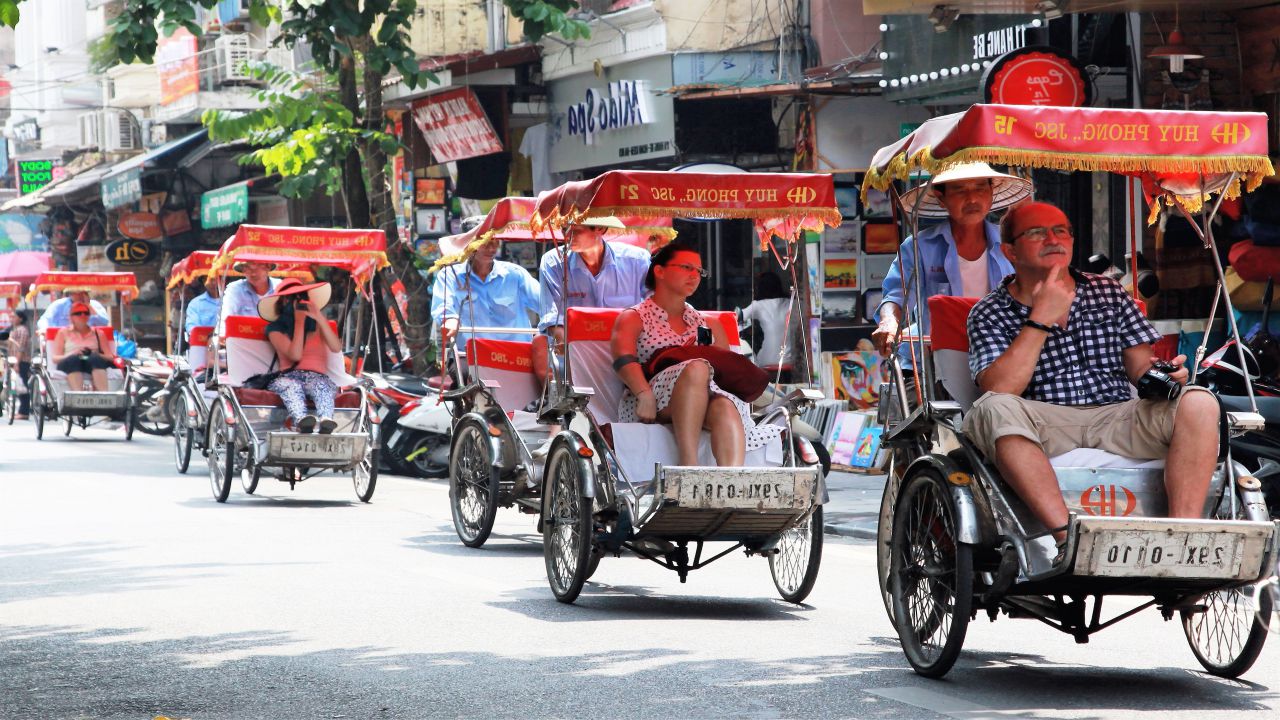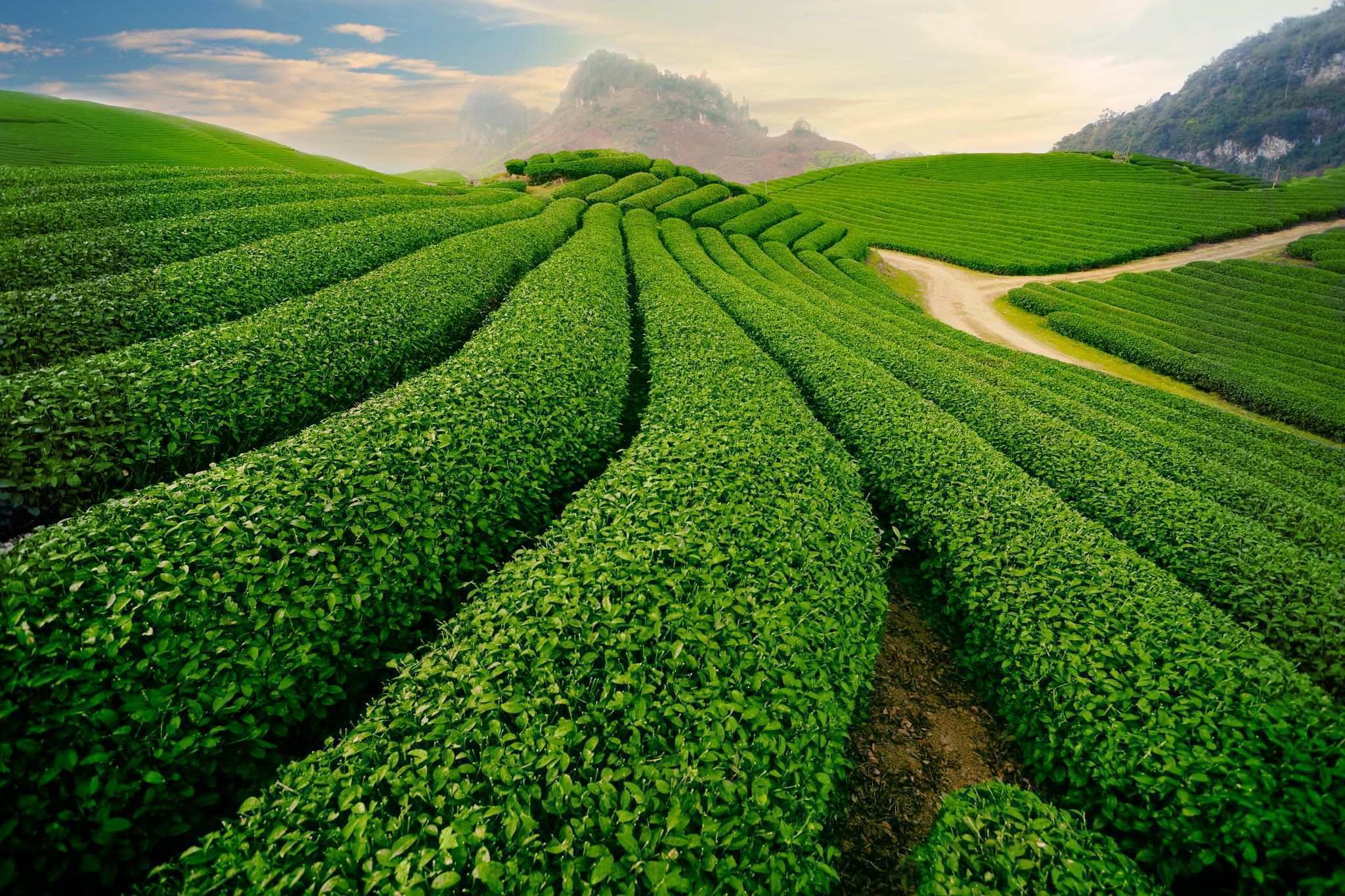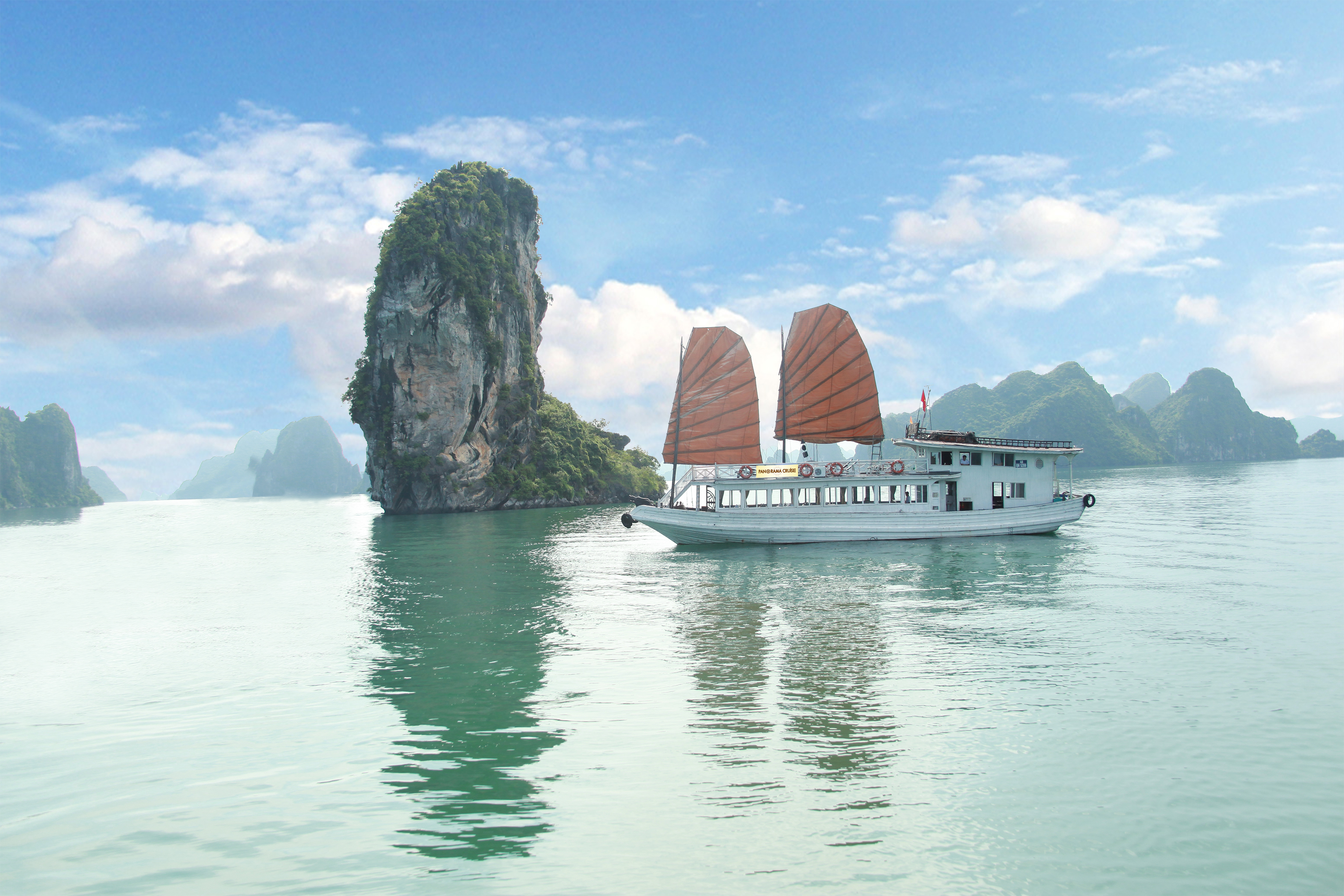DAY 1 : ARRIVE IN HA NOI
Arrival in Hanoi
Customs formalities and luggage recovery (Estimated time approximately 30 minutes).
You will then be greeted by your guide and driver, outside the airport, transfer to Hanoi city for a day tour of the city
Lunch at the restaurant
HANOI CITY : is the capital of Northern Vietnam and keeps this role until now. The city is located on the right bank of the Red River and far about 1760 kilometers from Ho Chi Minh City. Hanoi features a warm humid subtropical climate with plentiful precipitation. In addition, Hanoi is considered one of the main cultural centers of Vietnam, where most Vietnamese dynasties have left their imprint.
Hanoi Cyclo : an hour cycling around and take photos in the Old Quarter.

The Old Quarter (36 old streets) : has a history that spans 2,000 years and represents the eternal soul of the city. Ha Noi Old Quarter with its old-styled narrow streets full of antique brick houses seems to nostalgically resist the flow of time while still actively trying to adapt to the dynamic atmosphere of the modern city. Once a bustling area where merchants and artisans gathered to sell their products, Ha Noi Old Quarter consists of many small, meandering streets, each bears the name of the goods that was specifically traded there such as Hang Bac (Silver Product), Hang Ma (Paper Product), Hang Go (Wood Product), just to name a few.
Water Puppet show : is a tradition that dates back as far as the 11th century when it originated in the villages of the Red River Delta area of northern Vietnam. The puppets are made out of wood and then lacquered. The shows are performed in a waist-deep pool. A large bamboo rod supports the puppet under the water and is used by the puppeteers, who are normally hidden behind a screen, to control them. Thus the puppets appear to be moving over the water.
Free dinner and overnight at the hotel in Hanoi
DAY 2 : HANOI
Temple of Literature : founded in 1070 by Emperor Ly Thanh Tong, the Temple of Literature is dedicated to Confucius (Khong Tu). Inside you’ll find a pond known as the ‘Well of Heavenly Clarity’, a low-slung pagoda and statues of Confucius and his disciples. A rare example of well-preserved traditional Vietnamese architecture, the complex honours Vietnam’s finest scholars and men of literary accomplishment. It is the site of Vietnam’s first university, established here in 1076, when entrance was only granted to those of noble birth.
Ngoc Son Temple was built in the 18th century on Jade Island in the centre of the ‘Lake of the Returned Sword’ or Hoan Kiem Lake. Legend describes how an emperor was once given a magical sword which helped him defeat the Chinese Ming Dynasty and in doing so saw the return of the Golden Turtle God to the lake.
Hoan Kiem Lake (Lake of the Restored Sword) : refers to a legend of the great Vietnamese hero, Le Loi, who led a successful uprising against the Chinese in the fifteenth century. Tradition has it that Le Loi netted a gleaming sword while out fishing in a sampan and when he returned as King Ly Thai To, after ten years of battle, he wanted to thank the spirit of the lake. As he prepared the sacrifice there was a timely peal of thunder and the miraculous sword flew out of its scabbard, into the mouth of a golden turtle (Vietnamese use the same word for turtle and tortoise) sent by the gods to reclaim the weapon.

One pillar pagoda : a wooden pagoda on a single stone pillar, and it is designed to resemble a lotus blossom, which is a Buddhist symbol of purity, since a lotus blossoms in a muddy pond.
Lunch at the restaurant.
Then free time for shopping at Dong Xuan Market.
Dong Xuan market : is the oldest and largest market in Hanoi. Established in 1889, Dong Xuan Market is housed within a four-storey Soviet-style building on the northern edge of Hanoi Old Quarter. It’s also known as Hanoi’s largest indoor market, offering a wide range of goods such as fresh produce, souvenirs, accessories and clothing, as well as electronic and household appliances.
Ha Noi Opera house : was constructed for ten years from 1901 to 1911 and modeled on Palais Garnier – the older of Paris two opera houses, Hanoi Opera House embraces the European architectural style under the Renaissance period with the Italian-made marble floor, copper chandeliers and exquisite French murals on the ceiling, thus making the place one of Hanoi’s singular architectural landmarks.
At the end of the afternoon, you visit West lake ( Ho Tay) : is the biggest freshwater lake of northwest center of Hanoi, Vietnam. With a shore length of 17 km (about 10.6 miles) and 500 hectare (about 5 km2) in area, this is the largest lake of the capital and a popular place for recreation with many surrounding gardens, hotels and villas.
Tran Quoc Pagoda : is the oldest pagoda in the city, originally constructed in the sixth century during the reign of Emperor Lý Nam Đế (from 544 until 548), thus giving it an age of more than 1,450 years. When founded the temple was named Khai Quoc (National Founding) and was sited on the shores of the Red River, outside of the Yen Phu Dyke. When confronted with the river’s encroachment, the temple was relocated in 1615 to Kim Ngu (Golden Fish) islet of Ho Tay (West Lake) where it is now situated. A small causeway links it to the mainland.
Dinner and overnight at the hotel in Hanoi
DAY 3 : HANOI – MAI CHAU
Breakfast at the hotel
Depart to Mai Chau (130 km – 3h drive).
On the way, make a stop from time to time for beautiful pictures of the beautiful mountain scenery of North West Vietnam.
Arrival at Mai Chau around noon, lunch at the inhabitant.
Afternoon, small walk in the ethnic village in Mai Chau, one of the most beautiful valleys of North Vietnam where live the ethnic minorities Thai with their wooden houses on stilts which are bordered by green rice fields, small ponds.
Discovery of the traditional dances and customs of the original Thai spend the night in their house on stilts.
Overnight at homestay
DAY 4 : HANOI – NINH BINH
Breakfast at the inhabitant.
Depart to Son La via Moc Chau.
Son La : is 320km to the Northwest of Hanoi. The site is preserving historic objects – evidences of a difficult but heroic time during the war. Furthermore, Son La is a venue of ecoregions for ones who want fresh air, peacefulness and to mix with the nature. The valley is covered with coffee trees, plums or apricots.
Lunch at the restaurant.

Arrival at Son Visit to: Son La Prison and Ethnographic Museum.
Dinner and overnight at the hotel in Sơn La
DAY 5 : SON LA – DIEN BIEN PHU
Breakfast at the hotel en route to Dien Bien Phu.
Dien Bien : is a province in the northwest of Vietnam. Where have very beauty imposing natural landscape mixing with very diversified hill tribe’s cultures. This nice and quiet city is located in the Muong Thanh valley with a length of about 20 km and 6 km in width. Here also being known as ‘Dien Bien basin’. Dien Bien Phu is considered as one of the cities lying on the border, only about 35 km from city center to the border of Laos. Dien Bien Province is well-known for its heroic history with many relics and monuments.
Afternoon, arrival at Dien Bien Phu, visit of the city: museum of Dien Bien Phu, the Hill of Elianne, (famous during the war) and the center of command De Castries.
Lunch at the restaurant.

Visit the historic battlefield.
Overnight at the hotel in Dien Bien Phu.
DAY 6 : DIEN BIEN PHU – LAI CHAU
Breakfast at the hotel
Visit :
Visit the cemeteries to pay tribute to soldiers on both sides Vietnamese and French. General Giap’s headquarters during the Dien Bien Phu campaign in Muong Phang.
Then depart to Sapa, on the road visit :
the Nam Na River, a major tributary of the Black River, You can enjoy the road to admire the spectacular scenery, and make contact with local minorities like red H’mong, Dao.
Lunch at Phong Tho restaurant.
Arrival at Lai Chau at the end of the afternoon.
Overnight at the hotel in Lai Chau.
DAY 7 : LAI CHAU – SAPA
Breakfast at the hotel.
Then visit a beautiful village of Laos ethnic groups.
Laos women wear pretty cotton and welcome us warmly: their teeth, lacquered in black, give a particular smile. The people of Laos bathe still naked in the streams in summer. To go to the Laos ethnic village, you have to go through a suspension bridge, then a magnificent rice field.
Discovery of customs, customs and many contacts with local people.
After the visit of the village fresh and authentic, transfer to Sapa (about 2h of the road), the road climbs to the highest pass of Vietnam (2047m). Stop at the pass to enjoy the coolness and see Mount Fanxipan (3143m), the roof of Indochina.
Lunch at the restaurant

Arrive in Sapa, walk to visit the city Sapa or rest in the hotel.
DAY 8 : SAPA
Breakfast at the hotel
Then visit of:
SAPA : located in the north – west of Vietnam, about 350 km from Hanoi. It belongs to Lao Cai province, which a modest land but hides many wonders of the natural scene. The natural beauty of Sapa is combined with human creativity, the topography of the mountains, green forests, which creates romantic spot .
Then, we will climb the Ham Rong mountain (jaw of the dragon) where we can not miss the opportunity to take great pictures of the region. An interesting walk will take us to the theater where we will have the opportunity to attend the show of five dances of Sapa ethnic groups.
In the afternoon, we walk to the villages of black H’mong Lao Chai and Dzays Ta Van where we have opportunities to discover the specific cultures of each ethnic group.
Lunch at the restaurant

Dinner and overnight at the hotel in Sapa
DAY 9: SAPA – HANOI
Breakfast at the hotel
After breakfast at the hotel, we continue our hike to the village gate where our bus is waiting for us,
Walking tour to Cat Cat, the village of black H’mong. The walk leads us to the waterfall in the middle of the village, contacts with the H’mongs will offer interesting memories.
After lunch at the local restaurant, return to Lao Cai for a detour to Ta Phin village where we discover the ancient traditions of the Red Yaos. We return to Lao Cai, stop at the Sino-Vietnamese border where we see the confluence of the Red River (red) belonging to Vietnam and the Nam Thi River (green) to China.

Then return to Hanoi.
Night on board
DAY 10: HANOI – HALONG BAY
Arrival in Hanoi at 6:00. Head to Ha Long Pier for a memorable cruise on the bay.
Ha Long Bay : in the Gulf of Tonkin, includes some 1,600 islands and islets, forming a spectacular seascape of limestone pillars. It was called ‘the wonder standing in the heaven’. In the heart of stone islands, there have the beautiful caves such as Thien Cung Cave, Dau Go Cave, Sung Sot Cave, and Tam Cung Cave that are really the castles of the heaven. With the special values, on December 17th 1994, in the 18th session of World Heritage Committee of UNESCO, Halong Bay was officially recognized as the World natural heritage. In November 2000, Halong Bay was recognized by UNESCO as the World natural heritage about the values of geomorphology. On April 27th, officially stated that Halong Bay became one of the Seven Wonders of the World.
Halong Bay Cruise: On a junk, you’ll have a memorable cruise. Enjoy a delicious seafood meal on board and spend your day admiring one of Vietnam’s natural wonders.
Visit islets, caves, If the heart tells you, you can make a dip in the jade waters of the Gulf of Tonkin.
Lunch and return to the pier

Dinner and overnight on the junk in Halong
DAY 11 : HALONG BAY – HANOI
Breakfast at the hotel.
You will have the opportunity to see the sunrise over the bay. After we continue the cruise to Bai Tho Mountain in the other beautiful bay of Bai Tu Long.
.jpg)
Return to the pier around 10:30 am and have lunch at the restaurant at 11H.
Back to Hanoi
DAY 11 : HANOI – RETURN
Breakfast at the hotel.
Transfer airport for the return flight
Take off on … on the flight …
SFC Charity